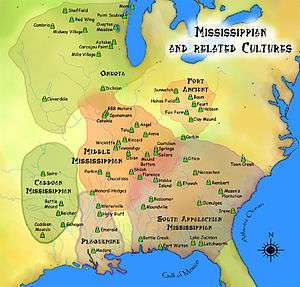Spiro Mounds
|
Spiro Mound Group | |
|
Artists conception of Spiro Mounds as seen from the west. | |
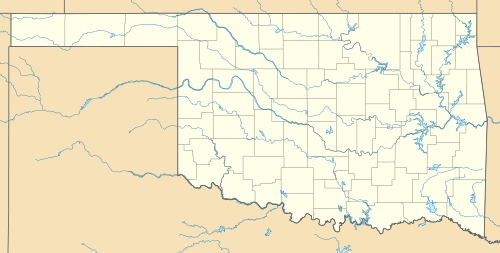  | |
| Nearest city | Spiro, Oklahoma |
|---|---|
| Coordinates | 35°18′43″N 94°34′07″W / 35.31194°N 94.56861°WCoordinates: 35°18′43″N 94°34′07″W / 35.31194°N 94.56861°W |
| Area | Le Flore County |
| Architectural style | Mississippian |
| NRHP Reference # | 69000153 |
| Added to NRHP | September 30, 1969[1][2] |
Spiro Mounds (34 LF 40)[3] is an important Mississippian archaeological site located in what is now Eastern Oklahoma. It lies near the Arkansas River seven miles north of the town of Spiro. Between the 9th and 15th centuries, the Spiro people created a powerful religious and political center based on the model of Mississippian Culture that thrived along the Mississippi River and its tributaries at that period. Spiro is considered the western-most outpost of Mississippian culture. Spiro Mounds is under the protection of the Oklahoma Historical Society, and is listed on the National Register of Historic Places.[4]
In the 1930s during the Great Depression treasure hunters bought the rights to tunnel into Craig Mound—the second-largest mound on the site—to mine it for artifacts. They exposed a hollow burial chamber inside the mound, a unique feature containing some of the most extraordinary pre-Columbian artifacts ever found in North America, including some of fragile materials: textiles and feathers uniquely preserved in the chamber. The treasure hunters sold the artifacts they recovered to art collectors, some as far away as Europe. Some of these artifacts were later returned, though some have never been accounted for. This site has been significant for North American archaeology since the 1930s, especially for defining the Southeastern Ceremonial Complex, a significant feature of the Mississippian tradition and a unifying element of culture extending into the American Southeast.
Mounds and plaza area

Mississippian culture spread along the lower Mississippi River and its tributaries between the 9th and 16th centuries. The largest Mississippian settlement was Cahokia, the capital of a major chiefdom that built a six-mile-square city east of what is now St. Louis, Missouri in present-day Southern Illinois. Mississippian culture ranged from the Great Lakes to the Gulf Coast, and along the Ohio River and into both the lowland and mountain areas of the Southeast. Mississippian settlements were known for their large platform earthwork mounds (usually truncated pyramids) surmounted by temples, the houses of warrior kings and priests, and the burial houses of the elite. Archaeological research has shown that Mississippian settlements like Cahokia and Spiro took part in a vast trading network that covered the eastern half of what is now the U.S. and parts of what is now the Western U.S. as well.
The Spiro site includes twelve earthen mounds and 150 acres of land.[4] As in other Mississippian-culture towns, the people built a number of large, complex earthworks. These included mounds surrounding a large, planned and leveled central plaza, where important religious rituals, the politically and culturally significant game of chunkey, and other important community activities were carried out. The population lived in a village that bordered the plaza. In addition, archaeologists have found more than twenty related village sites within five miles of the main town. Other village sites linked to Spiro through culture and trade have been found up to a 100 miles (160 km) away.
Spiro has been the site of human activity for at least 8000 years. It was a major Mississippian settlement from 800 to 1450.[4] The cultivation of maize allowed accumulation of crop surpluses and the gathering of more dense populations. It was the headquarters town of a regional chiefdom, whose powerful leaders directed the building of eleven platform mounds and one burial mound in an 80-acre (0.32 km2) area on the south bank of the Arkansas River. The heart of the site is a group of nine mounds surrounding an oval plaza. These mounds were the bases of the homes of important leaders or formed the foundations for religious structures that focused the attention of the community. Brown Mound, the largest platform mound, is located on the eastern side of the plaza. It had an earthen ramp that gave access to the summit from the north side. Here, atop Brown Mound and the other mounds, the town's inhabitants carried out complex rituals, centered especially on the deaths and burials of Spiro's powerful rulers.
Archaeologists have shown that Spiro had a large resident population until about 1250. After that, most of the population moved to other towns nearby. Spiro continued to be used as a regional ceremonial center and burial ground until about 1450. Its ceremonial and mortuary functions continued and seem to have grown after the main population moved away.
The Great Mortuary

Craig Mound – also called "The Spiro Mound" – is the second-largest mound on the site and the only burial mound. It is located about 1,500 feet (460 m) southeast of the plaza. A cavity created within the mound, about 10 feet (3.0 m) high and 15 feet (4.6 m) wide, allowed for almost perfect preservation of fragile artifacts made of wood, conch shell, and copper. The conditions in this hollow space were so favorable that objects made of perishable materials such as basketry, woven fabric of vegetal and animal fibers, lace, fur, and feathers were preserved inside it. Such objects have traditionally been created by women in historic tribes. Also found inside were several examples of Mississippian stone statuary made from Missouri flint clay and Mill Creek chert bifaces, all thought to have originally come from the Cahokia site in Illinois.
The "Great Mortuary," as archaeologists called this hollow chamber, appears to have begun as a burial structure for Spiro's rulers. It was created as a circle of sacred cedar posts sunk in the ground and angled together at the top like a tipi. The cone-shaped chamber was covered with layers of earth to create the mound, and it never collapsed. Some scholars believe that minerals percolating through the mound hardened the chamber's log walls, making them resistant to decay and shielding the perishable artifacts inside from direct contact with the earth. No other Mississippian mound has been found with such a hollow space inside it and with such spectacular preservation of artifacts. Craig Mound has been called "an American King Tut's Tomb."
Between 1933 and 1935, Craig Mound was excavated by an enterprise that had bought the rights to excavate, and to keep or sell the artifacts they recovered. Tunneling into the mound and breaking through the Great Mortuary's log wall, they found many human burials, together with their associated grave goods. They discarded the human remains and the fragile artifacts—made of textile, basketry, and even feathers—that were preserved in these extremely unusual conditions. Most of these rare and historically priceless objects disintegrated before scholars could reach the site, although some were sold to collectors.[5] When the commercial excavators finished, they dynamited the burial chamber and sold the commercially valuable artifacts, made of stone, pottery, copper, and conch shell, to collectors in the United States and overseas. Most of these valuable objects are probably lost, but some have been returned through donation and documented by scholars.
 "Resting Warrior", side view, effigy pipe of Missouri flint clay
"Resting Warrior", side view, effigy pipe of Missouri flint clay_effigy_pipe_HRoe-2010.jpg) Effigy pipe of figure smoking from a frog effigy pipe, Missouri flint clay
Effigy pipe of figure smoking from a frog effigy pipe, Missouri flint clay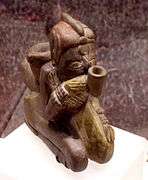 Effigy pipe of a man smoking a pipe, Missouri flint clay
Effigy pipe of a man smoking a pipe, Missouri flint clay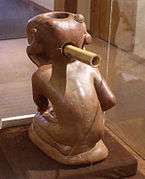 "Lucifer" pipe, rear view
"Lucifer" pipe, rear view
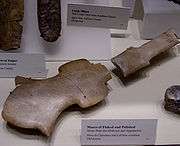 Ceremonial monolithic flint mace
Ceremonial monolithic flint mace Copper ear spools
Copper ear spools Engraved whelk shell cup with raptor heads
Engraved whelk shell cup with raptor heads
Archaeologists from the University of Oklahoma excavated parts of the site between 1936 and 1941. The Oklahoma Historical Society established the "Spiro Mounds Archaeological Center," which opened in 1978.[4] The site is listed on the National Register of Historic Places and is preserved as Oklahoma's only Archeological State Park.
Southeastern Ceremonial Complex

Spiro Mounds people participated in what archaeologists call the Southeastern Ceremonial Complex (SECC), a network of ceremonial centers sharing the Mississippian culture and similar spiritual beliefs, cosmology, ritual practices, and cult objects. The SECC was a vast trading network that distributed exotic materials for making ritual objects from all across North America. These included colored flint from New Mexico, copper from the Great Lakes, conch (or lightning whelk) shells from the Gulf Coast, and mica from the Carolinas.[6] Other Mississippian centers also traded in these prized resources, but Spiro was apparently the only one that acquired obsidian from Mexico.[7] Using these valued materials, Mississippian artists created exquisite works of art reflecting their cultural identity and their complex spiritual beliefs.
When commercial excavators dug into Craig Mound, they found many beautifully crafted ritual artifacts, including stone effigy pipes, polished stone maces, finely made flint knives and arrowpoints, polished chunkey stones, copper effigy axes, Mississippian copper plates (Spiro plates), mica effigy cut outs, elaborately engraved conch shell ornaments, pearl bead necklaces, stone earspools, wood carvings inlaid with shell, and specially made mortuary pottery. The conch shells were fashioned into gorgets and drinking cups engraved with intricate designs representing costumed men, real and mythical animals, and geometric motifs, all of which had profound symbolic significance. Spiro Mounds' ceremonial objects are among the finest examples of pre-Columbian art in North America.
Later, archaeologists identified artifacts at Spiro that appeared to have come from other powerful Mississippian towns far from present-day Oklahoma that also participated in the Southeastern Ceremonial Complex. These include Cahokia in Illinois, the largest Mississippian community; Etowah and Ocmulgee in Georgia; and Moundville in Alabama. In economic terms, Spiro seems to have been a gateway town that funneled valuable resources from the Great Plains and other western regions to the main Mississippian ceremonial centers farther east. In return, it received valuable goods back from those other centers. Spiro's location on the Arkansas River, one of the Mississippi's principal tributaries, gave it access to the Mississippian heartland hundreds of miles away.
Spiro and other Mississippian towns clearly looked to the great city of Cahokia, in what is now southern Illinois, as a cultural model to be emulated. Located about 400 miles northeast of Spiro near the confluence of the Mississippi and Missouri Rivers, Cahokia was the largest and most impressive of all the Mississippian towns. Mineralogical analysis of some of the most beautiful stone effigy pipes found at Spiro, including the famous "Grizzly Man" or "Kneeling Rattler" pipe, have shown they came from Cahokia, based on the material from which they were made.[8] Cahokia also influenced the styles of the artifacts made at Spiro. Archaeologists have identified four distinct styles: the Braden Style characteristic of artifacts brought from Cahokia; and the Craig A, B, and C styles, which are local derivatives of the Braden Style.[8][9]
Antonio Waring and Preston Holder first defined the Southeastern Ceremonial Complex in the 1940s, according to a series of distinct cultural traits.[10] Since the late 1980s, archaeologists have adopted a new classification scheme based on their greatly improved understanding of Mississippian cultural development. The new scheme divides the SECC into five periods, or horizons, each defined by the appearance of new ritual objects and cultural motifs connected with new developments in politics and long-distance trade.[11] Archaeologists have determined that Spiro was at the peak of its cultural importance in the 13th and 14th centuries.
Mississippian iconography

Archaeologists have tried in recent years to interpret the meaning of the ritual artifacts and artistic imagery found at Spiro and other Mississippian sites. While reaching firm conclusions about the meanings of works of art made centuries ago by people of an extinct culture is difficult, archaeologists have made some compelling interpretations by comparing Mississippian artistic imagery with the myths, religious rituals, art, and iconography of historic Native American groups.
One of the most prominent symbols at Spiro is the "Birdman," a winged human figure representing a warrior or chunkey player. Chunkey was a game played in the Mississippian period, but also in historic times by the Choctaw, Chickasaw, Cherokee, and other Southeastern tribes. Men played the game by rolling a stone disk for a considerable distance and then hurling spears as close as they could to the point where the stone stopped. The players placed heavy bets on the game — sometimes all their possessions — and some committed suicide when they lost. The Birdman seems to be a supernatural being connected with the Upper World, the sky, and the male virtues of warfare and high-stakes competition. Archaeologists believe it may be related to Red Horn, a mythic culture hero among the historic Winnebago and other Siouan tribes. Red Horn was often identified as a bright star in the sky.
Another Spiro icon is the "Great Serpent," a being said to inhabit the Under World, the spiritual domain on the opposite side of the Mississippian universe. The Great Serpent is portrayed in Mississippian art with a serpent's body but also with wings or horns. Similar beings were the subject of myth in historic times among the Micmac, Huron, Kickapoo, Cherokee, Muscogee Creek, Caddo, and other Native American tribes. The spiritual beings of the Under World were thought to be in constant opposition to those in the Upper World. Men had to fear these beings, according to Native American mythology, but they could also gain great power from them in certain circumstances.
Mississippian art also features the cedar tree or striped-center-pole motifs, which archaeologists have interpreted as the axis mundi, the point at which the three parts of the Mississippian spiritual universe come together: the Upper World, the Under World, and the Middle World where humans dwell. The cedar tree or the striped-center-pole is often found on engraved conch shell gorgets, with human or animal figures positioned on either side. The concept of an axis mundi — the point where different cosmic domains converge — is found in many cultures around the world. It is frequently represented as a tree (including the Tree of Life), since trees pass through the surface of the earth to link the subsurface and the sky. The fact that the Great Mortuary at Spiro was built with cedar (or cedar elm) posts suggests that the burial chamber was meant to be a point of departure from one spiritual domain to another, as cedar was a sacred wood.
Archaeologists found that one of the conch shell cups from Craig Mound had a black residue in the bottom. This suggests that the Spiro people may have practiced a version of the Black Drink Ceremony, a purification ritual that was also performed in historic times by their descendants - the Southeastern tribes. Participants drank a tea made from the Yaupon Holly from conch shell cups.[12] The Black Drink Ceremony was performed by men only. The highest-ranking members drank first, followed in turn by those of lesser rank. The men often drank until they vomited this powerful caffeine-rich brew, which they used in a ritual of spiritual cleansing and renewal.
Decline
Spiro’s decline as a population center began about 1250, although it continued to be a ceremonial and mortuary center until 1450.[13] The mound area was abandoned about 1450, although nearby communities persisted until 1600.[4] The cultures following in the wake of Spiro were less complex and hierarchical.[14]
The gradual decline of Spiro as a population and ceremonial center may have been due to the exhaustion of local resources, forcing its inhabitants to move elsewhere in search of better soil and timber. Spiro may also have lost its position as a trade center due to population movements or shifts in major trade routes to other locations. One possibility is that the people of Spiro came to depend less on agriculture for subsistence and more upon bison for their livelihood. Bison populations on the southern Great Plains are believed to have increased after 1250. The inhabitants of Spiro and other cultures in Oklahoma may have found bison-hunting more productive than agriculture and adapted their culture accordingly. A hunting society would have been more mobile, less hierarchical, and less likely to undertake major construction projects than the settled farmers of Spiro’s golden age.[15]
Most authorities agree that the people of Spiro were Caddoan speaking, but their descendants in historic times are difficult to identify. Archaeologists speculate that the Caddo Confederacy, Wichita, Kichai, or non-Caddoan Tunica are their descendants. However, the cultures of all these peoples, when encountered by the Spanish and French in the 16th and 17th centuries, were substantially different from that of Spiro.[16]
Under the Native American Graves Protection and Repatriation Act, the Caddo Nation of Oklahoma and the Wichita and Affiliated Tribes (Wichita, Keechi, Waco and Tawakonie) are recognized by the US Federal government and archaeologists as the cultural descendants of the builders of Spiro Mounds.[17]
Caddoan Mississippians

When the Spanish conquistador Hernando de Soto led an expedition into what is now the Southeastern United States in the 1540s, he encountered a Native American group known as the Caddo. Composed of many tribes, the Caddo were organized into three confederacies, the Hasinai, Kadohadacho, and Natchitoches, which were all linked by similar languages.
At the time of de Soto's visit, the Caddo controlled a large territory. It included what is now Eastern Oklahoma, Western Arkansas, Northeast Texas, and Northwest Louisiana. Archaeologists have thought that the Caddo and related peoples had been living in the region for centuries and that they had their own local variant of Mississippian culture.
Recent excavations have revealed within that region more cultural diversity than scholars had expected. The sites along the Arkansas River, in particular, seem to have their own distinctive characteristics. Scholars still classify the Mississippian sites found in the entire Caddo area, including Spiro Mounds, as "Caddoan Mississippian".[18]
The Caddoan Mississippian region contained many towns in addition to Spiro, including the Battle Mound Site. Scholars have determined that Battle Mound, lying along the Great Bend of the Red River in Southwest Arkansas, was a larger site than Spiro. Little excavation has been done there to date. The Caddoan Mississippian towns had a more irregular layout of earthen mounds and associated villages than did towns in the Middle Mississippian heartland to the east. They also lacked the wooden palisade fortifications often found in the major Middle Mississippian towns. Living on the western edge of the Mississippian world, the Caddoan may have faced fewer military threats from their neighbors. Their societies may also have had a somewhat lower level of social stratification.
The Spiro people were probably speakers of one of the many Caddoan languages.[19] The Caddoan languages once had a broad geographic distribution, but many are now extinct. The modern languages in the Caddoan family include Caddo and Pawnee. Both are now spoken mainly by elderly people.
See also
- Mississippian Culture
- Cahokia
- Southeastern Ceremonial Complex
- Caddoan Mississippian culture
- Mississippian stone statuary
- Mississippian copper plates
- Shell gorgets
- List of Mississippian sites
References
- ↑ "OKLAHOMA - Le Flore County". National Register of Historic Places. National Park Service. 2007-01-23.
- ↑ "National Register Properties in Oklahoma". Retrieved 28 February 2009.
- ↑ Brown, James A.; Rogers, J. Daniel (Summer 1989). "Linking Spiro's artistic styles: The Copper Connection". Southeastern Archaeology. Allen Press. 8 (1): 1–8. JSTOR 40712893.
- 1 2 3 4 5 "Spiro Mounds." Oklahoma Historical Society. (retrieved 30 May 2011)
- ↑ Dean R. Snow (2010). Archaeology of Native North America. Prentice-Hall. p. 214.
- ↑ "Spiro Mounds-A Ceremonial Center of the Southern Cult". Retrieved 13 August 2009.
- ↑ Pauketat, Timothy R. (2004). Ancient Cahokia and the Mississippians. Cambridge University Press. ISBN 0-521-52066-5.
- 1 2 Townsend, Richard F. (2004). Hero, Hawk, and Open Hand. Yale University Press. ISBN 0-300-10601-7.
- ↑ F. Kent Reilly; James Garber, eds. (2004). Ancient Objects and Sacred Realms. University of Texas Press. ISBN 978-0-292-71347-5.
- ↑ Waring, A.J. Jr. (1968). "The Southeastern Cult and Muskogean Ceremonial". In Williams, S. The Waring Papers: The Collected Work of Antonio J. Waring. Harvard University. pp. 30–69.
- ↑ Muller, Jon (1989). "The Southern Cult". In Galloway, Patricia. Southern Ceremonial Complex, Artifacts and Analysis: The Cottonlandia Complex. University of Nebraska Press. pp. 11–26.
- ↑ Hudson, Charles M. (1979). Black Drink. University of Georgia Press. pp. 83–112.
- ↑ ”Caddo Fundamentals: Spiro and the Arkansas Basin.” accessed 30 May 2011
- ↑ Rogers, J. Daniel “Chronology and the Demise of Chiefdoms: Eastern Oklahoma in the Sixteenth and Seventeenth Centuries." Southeastern Archaeology, 25 (1), Retrieved 2 Sep 2008 from Research Library database. (Doocument ID: 1158326791)
- ↑ Rogers
- ↑ "Caddo Fundamentals: Spiro and the Arkansas Basin." accessed 30 May 2011
- ↑ "Notice of Inventory Completion: Texas Archeological Research Laboratory, The University of Texas at Austin, Austin, TX." Federal Registrar. 29 May 2008 (retrieved 30 May 2011)
- ↑ Peter N. Peregrine (1995). Archaeology of the Mississippian culture: a research guide. Garland Publishing. p. 165. ISBN 978-0-8153-0336-7.
- ↑ "Tejas-Caddo Fundamentals-Caddoan Languages and Peoples". Retrieved 2010-02-04.
Further reading
- Brown, James Allison & Alice Brues. The Spiro Ceremonial Center: The Archaeology of Arkansas Valley Caddoan Culture in Eastern Oklahoma, Ann Arbor: Museum of Anthropology, University of Michigan, 1996.
- Hamilton, Henry, Jean Tyree Hamilton, & Eleanor Chapman. Spiro Mound Copper, Columbia, MO: Missouri Archaeological Society, 1974.
- Hudson, Charles M. (ed.). Black Drink: A Native American Tea, Athens, GA: University of Georgia Press, 2004.
- La Vere, David. Looting Spiro Mounds: An American King Tut's Tomb, Norman, OK: University of Oklahoma Press, 2007.
- Merriam, Larry & Christopher Meriam. The Spiro Mound, A Photo Essay: Photographs from the Collection of Dr. Robert E. Bell, Oklahoma City: Merriam Station Books, 2004.
- Pauketat, Timothy R. The Ascent of Chiefs: Cahokia and Mississippian Politics in Native North America, Tuscaloosa, AL: University of Alabama, 1994.
- Pauketat, Timothy R. Ancient Cahokia and the Mississippians, London: Cambridge University Press, 2004.
- Pauketat, Timothy R. and Thomas E. Emerson (eds.). Cahokia: Domination and Ideology in the Mississippian World, Lincoln: University of Nebraska Press: 1997.
- Phillips, Philip & James Allison Brown. Pre-Columbian Shell Engravings from the Craig Mound at Spiro, Oklahoma, Cambridge, MA: Peabody Museum Press, 1984.
- Reilly, F. Kent and James F. Garber (eds.). Ancient Objects and Sacred Realms: Interpretations of Mississippian Iconography, Austin, TX: University of Texas Press, 2007.
- Townsend, Richard F. Hero, Hawk, and Open Hand: American Indian Art of the Ancient Midwest and South, Chicago, IL: Art Institute of Chicago, 2004.
External links
| Wikimedia Commons has media related to Spiro Site. |
| Wikimedia Commons has media related to Mississippian iconography. |
- Spiro Mounds Archaeological Park
- Spiro Mounds Archaeological Center on TravelOK.com Official travel and tourism website for the State of Oklahoma
- Spiro Mounds Information & Videos - Chickasaw.TV
- Arkansas Antiquities
- Spiro and the Arkansas Basin
- Encyclopedia of Oklahoma History and Culture
- Oklahoma Archeological Survey
- Southernhistory.com
- Spiromound.com
- Destruction of Craig Mound
- Spiro Mounds Bibliography
- Caddoan Mississippian Culture
- "Towns and Temples of the Mississippian Culture" (animation video)
- Spiro Mounds on Oklahoma Historical Society
- The Spiro Mounds Site
- Historic American Landscapes Survey (HALS) No. OK-37, "Spiro Mounds Site, 18154 First Street, Spiro, Le Flore, OK"

